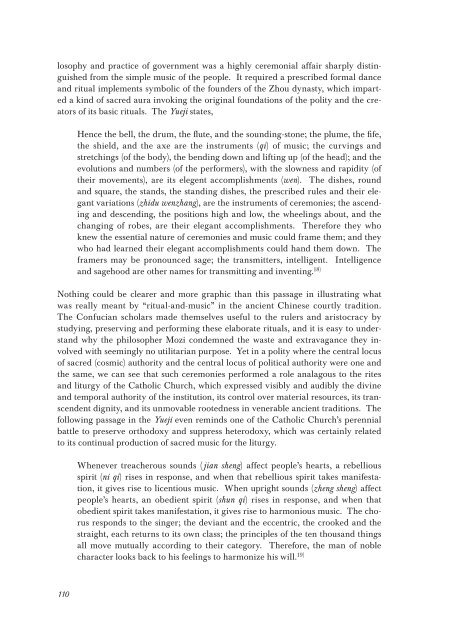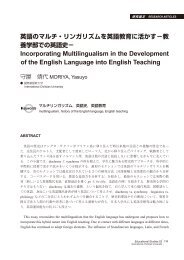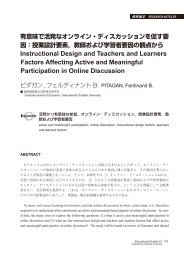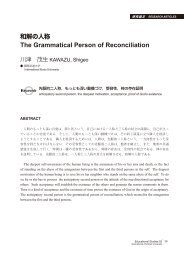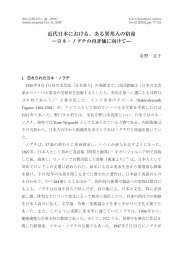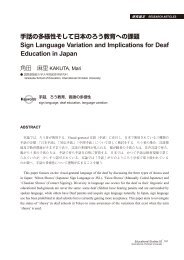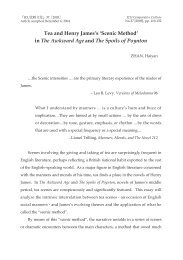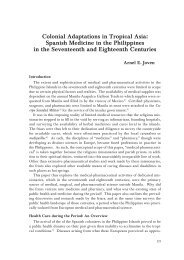The Culture of Music and Ritual in Pre-Han Confucian - subsite
The Culture of Music and Ritual in Pre-Han Confucian - subsite
The Culture of Music and Ritual in Pre-Han Confucian - subsite
You also want an ePaper? Increase the reach of your titles
YUMPU automatically turns print PDFs into web optimized ePapers that Google loves.
losophy <strong>and</strong> practice <strong>of</strong> government was a highly ceremonial affair sharply dist<strong>in</strong>guished<br />
from the simple music <strong>of</strong> the people. It required a prescribed formal dance<br />
<strong>and</strong> ritual implements symbolic <strong>of</strong> the founders <strong>of</strong> the Zhou dynasty, which imparted<br />
a k<strong>in</strong>d <strong>of</strong> sacred aura <strong>in</strong>vok<strong>in</strong>g the orig<strong>in</strong>al foundations <strong>of</strong> the polity <strong>and</strong> the creators<br />
<strong>of</strong> its basic rituals. <strong>The</strong> Yueji states,<br />
110<br />
Hence the bell, the drum, the flute, <strong>and</strong> the sound<strong>in</strong>g-stone; the plume, the fife,<br />
the shield, <strong>and</strong> the axe are the <strong>in</strong>struments (qi) <strong>of</strong> music; the curv<strong>in</strong>gs <strong>and</strong><br />
stretch<strong>in</strong>gs (<strong>of</strong> the body), the bend<strong>in</strong>g down <strong>and</strong> lift<strong>in</strong>g up (<strong>of</strong> the head); <strong>and</strong> the<br />
evolutions <strong>and</strong> numbers (<strong>of</strong> the performers), with the slowness <strong>and</strong> rapidity (<strong>of</strong><br />
their movements), are its elegent accomplishments (wen). <strong>The</strong> dishes, round<br />
<strong>and</strong> square, the st<strong>and</strong>s, the st<strong>and</strong><strong>in</strong>g dishes, the prescribed rules <strong>and</strong> their elegant<br />
variations (zhidu wenzhang), are the <strong>in</strong>struments <strong>of</strong> ceremonies; the ascend<strong>in</strong>g<br />
<strong>and</strong> descend<strong>in</strong>g, the positions high <strong>and</strong> low, the wheel<strong>in</strong>gs about, <strong>and</strong> the<br />
chang<strong>in</strong>g <strong>of</strong> robes, are their elegant accomplishments. <strong>The</strong>refore they who<br />
knew the essential nature <strong>of</strong> ceremonies <strong>and</strong> music could frame them; <strong>and</strong> they<br />
who had learned their elegant accomplishments could h<strong>and</strong> them down. <strong>The</strong><br />
framers may be pronounced sage; the transmitters, <strong>in</strong>telligent. Intelligence<br />
<strong>and</strong> sagehood are other names for transmitt<strong>in</strong>g <strong>and</strong> <strong>in</strong>vent<strong>in</strong>g. 18)<br />
Noth<strong>in</strong>g could be clearer <strong>and</strong> more graphic than this passage <strong>in</strong> illustrat<strong>in</strong>g what<br />
was really meant by “ritual-<strong>and</strong>-music” <strong>in</strong> the ancient Ch<strong>in</strong>ese courtly tradition.<br />
<strong>The</strong> <strong>Confucian</strong> scholars made themselves useful to the rulers <strong>and</strong> aristocracy by<br />
study<strong>in</strong>g, preserv<strong>in</strong>g <strong>and</strong> perform<strong>in</strong>g these elaborate rituals, <strong>and</strong> it is easy to underst<strong>and</strong><br />
why the philosopher Mozi condemned the waste <strong>and</strong> extravagance they <strong>in</strong>volved<br />
with seem<strong>in</strong>gly no utilitarian purpose. Yet <strong>in</strong> a polity where the central locus<br />
<strong>of</strong> sacred (cosmic) authority <strong>and</strong> the central locus <strong>of</strong> political authority were one <strong>and</strong><br />
the same, we can see that such ceremonies performed a role analagous to the rites<br />
<strong>and</strong> liturgy <strong>of</strong> the Catholic Church, which expressed visibly <strong>and</strong> audibly the div<strong>in</strong>e<br />
<strong>and</strong> temporal authority <strong>of</strong> the <strong>in</strong>stitution, its control over material resources, its transcendent<br />
dignity, <strong>and</strong> its unmovable rootedness <strong>in</strong> venerable ancient traditions. <strong>The</strong><br />
follow<strong>in</strong>g passage <strong>in</strong> the Yueji even rem<strong>in</strong>ds one <strong>of</strong> the Catholic Church’s perennial<br />
battle to preserve orthodoxy <strong>and</strong> suppress heterodoxy, which was certa<strong>in</strong>ly related<br />
to its cont<strong>in</strong>ual production <strong>of</strong> sacred music for the liturgy.<br />
Whenever treacherous sounds (jian sheng) affect people’s hearts, a rebellious<br />
spirit (ni qi) rises <strong>in</strong> response, <strong>and</strong> when that rebellious spirit takes manifestation,<br />
it gives rise to licentious music. When upright sounds (zheng sheng) affect<br />
people’s hearts, an obedient spirit (shun qi) rises <strong>in</strong> response, <strong>and</strong> when that<br />
obedient spirit takes manifestation, it gives rise to harmonious music. <strong>The</strong> chorus<br />
responds to the s<strong>in</strong>ger; the deviant <strong>and</strong> the eccentric, the crooked <strong>and</strong> the<br />
straight, each returns to its own class; the pr<strong>in</strong>ciples <strong>of</strong> the ten thous<strong>and</strong> th<strong>in</strong>gs<br />
all move mutually accord<strong>in</strong>g to their category. <strong>The</strong>refore, the man <strong>of</strong> noble<br />
character looks back to his feel<strong>in</strong>gs to harmonize his will. 19)


